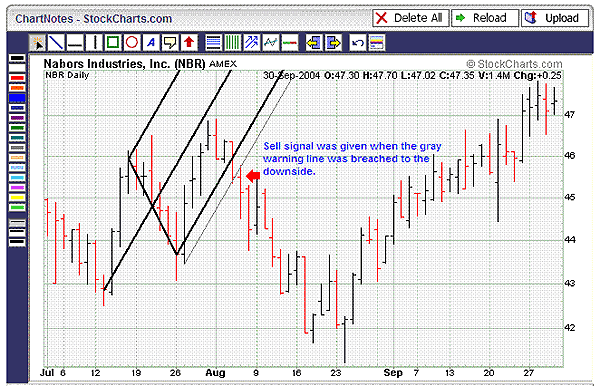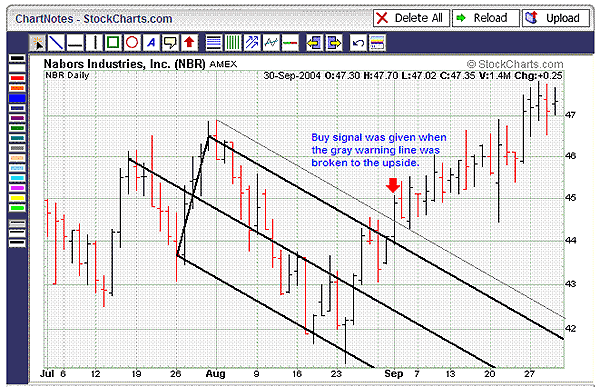
HOT TOPICS LIST
- MACD
- Fibonacci
- RSI
- Gann
- ADXR
- Stochastics
- Volume
- Triangles
- Futures
- Cycles
- Volatility
- ZIGZAG
- MESA
- Retracement
- Aroon
INDICATORS LIST
LIST OF TOPICS
PRINT THIS ARTICLE
by Kevin Hopson
This technique can help traders determine short-term entry and exit points.
Position: N/A
Kevin Hopson
Kevin has been a technical analyst for roughly 10 years now. Previously, Kevin owned his own business and acted as a registered investment advisor, specializing in energy. He was also a freelance oil analyst for Orient Trading Co., a commodity futures trading firm in Japan. Kevin is currently a freelance writer.
PRINT THIS ARTICLE
TECHNICAL ANALYSIS
The Mini-Pitchfork Technique
12/27/04 01:17:17 PMby Kevin Hopson
This technique can help traders determine short-term entry and exit points.
Position: N/A
| If you have read my articles, you are aware of my utilization of pitchfork analysis. However, one technique I have failed to touch on is the mini-pitchfork. The mini-pitchfork is similar to the regular pitchfork, but with a couple of exceptions. First of all, instead of using highs and lows as pivot points, the mini-pitchfork uses closing prices. Second, mini-pitchforks are generally used for short-term trading purposes, while regular pitchforks can be utilized for much longer time frames. |
| If you look at Figure 1 for Nabors Industries (NBR), you will see what I am talking about. Note how I used closing prices on the bar chart as my pivot points. The closing price is the line to the right of the bar. When drawing a mini-pitchfork, you want to use either a high-low-high combination or a low-high-low combination. In this example, I used the low-high-low combination of closing prices. In addition, you want to keep the time between each pivot point at a minimum (only a few days if possible). |

|
| Figure 1: Nabors Industries (NBR), sell signal. Note how closing prices on the bar chart were used as pivot points. |
| Graphic provided by: StockCharts.com. |
| |
| As you can see in Figure 1, a short-term sell signal was given when prices breached the gray warning line. Just to clarify, when prices move below the bottom parallel line of an uptrending pitchfork, a warning line is drawn from the initial low. You do not want to use the low from the third pivot point price bar (red bar). Instead, you want to use the first low thereafter (black bar). Note how prices closed right at the warning line in early August. When the stock opened beneath the warning line the next day and proceeded to find resistance here (daily high), it was a signal to sell. |
In Figure 2, the outcome is just the opposite. More specifically, note how prices had been contained within the black pitchfork for the entire month of August. When the stock broke above the gray warning line, it was a signal to go long. Not only that, note how prices found support along the warning line during the initial pullback. You see this a lot with pitchforks, as prior resistance tends to act as support and vice versa. In the meantime, try using mini-pitchforks in your short-term trading strategy and see how they work. Though they are not utilized as much as regular pitchforks, they can be effective in determining good short-term entry and exit points. Figure 2: Opposite outcome. Note how prices had been contained within the black pitchfork for the entire month of August. |
Kevin has been a technical analyst for roughly 10 years now. Previously, Kevin owned his own business and acted as a registered investment advisor, specializing in energy. He was also a freelance oil analyst for Orient Trading Co., a commodity futures trading firm in Japan. Kevin is currently a freelance writer.
| Glen Allen, VA | |
| E-mail address: | hopson_1@yahoo.com |
Click here for more information about our publications!
Comments
Date: 12/28/04Rank: 2Comment:
Date: 12/29/04Rank: 5Comment:

|

Request Information From Our Sponsors
- StockCharts.com, Inc.
- Candle Patterns
- Candlestick Charting Explained
- Intermarket Technical Analysis
- John Murphy on Chart Analysis
- John Murphy's Chart Pattern Recognition
- John Murphy's Market Message
- MurphyExplainsMarketAnalysis-Intermarket Analysis
- MurphyExplainsMarketAnalysis-Visual Analysis
- StockCharts.com
- Technical Analysis of the Financial Markets
- The Visual Investor
- VectorVest, Inc.
- Executive Premier Workshop
- One-Day Options Course
- OptionsPro
- Retirement Income Workshop
- Sure-Fire Trading Systems (VectorVest, Inc.)
- Trading as a Business Workshop
- VectorVest 7 EOD
- VectorVest 7 RealTime/IntraDay
- VectorVest AutoTester
- VectorVest Educational Services
- VectorVest OnLine
- VectorVest Options Analyzer
- VectorVest ProGraphics v6.0
- VectorVest ProTrader 7
- VectorVest RealTime Derby Tool
- VectorVest Simulator
- VectorVest Variator
- VectorVest Watchdog
